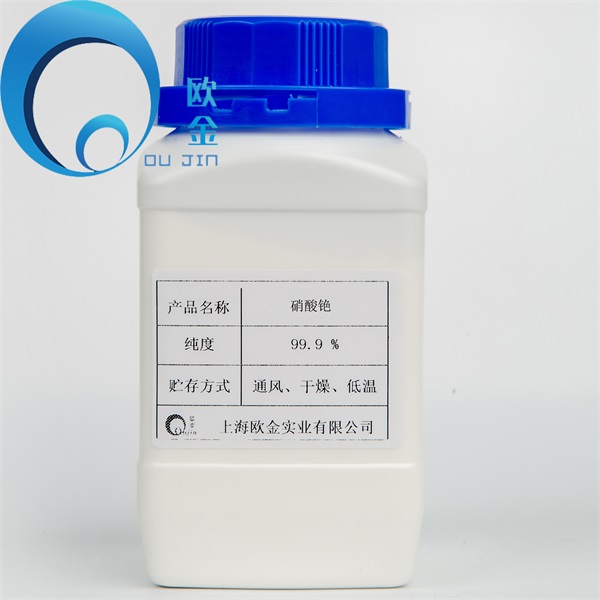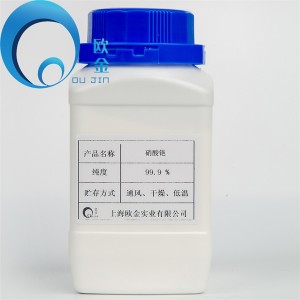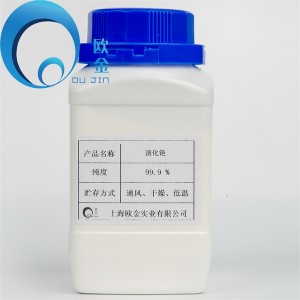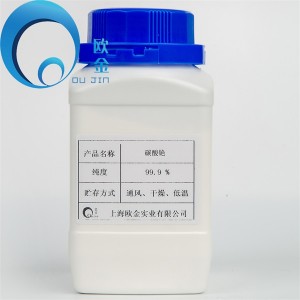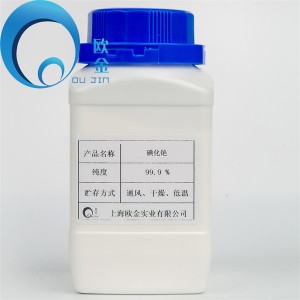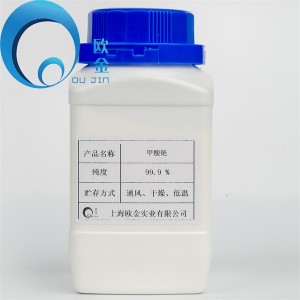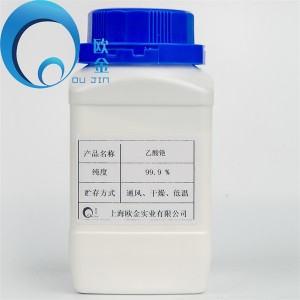
Products
Cesium Nitrate
Cesium nitrate, chemical formula CsNO ₃, is a kind of inorganic compounds, under atmospheric pressure is white crystalline powder, easily deliquescent, mainly used for cesium salt manufacturing. It has irritant action to eyes, skin mucous membrane and upper respiratory tract.
The material information
Chinese name: cesium nitrate
English names: Cesiumnitratewhitextl; Cesium nitrate (99.9% Cs)
CAS no. : 7789-18-6
Molecular formula: CsNO3
Molecular weight: 194.91000
Precise quality: 194.89300
PSA: 68.88000
LogP: 0.28410
Control information: cesium nitrate (explosive); This product is controlled by the public security department according to the Regulations on the Safety Administration of Hazardous Chemicals.
Numbering system
CAS no. : 7789-18-6
MDL number: MFCD00010963
EINECS no. : 232-146-8
RTECS number: FL0700000
PubChem number: 24852142
Physical property data
1. Properties: white crystalline powder, easy to be delirious, with salt and saltpetrum taste.
Melting point (℃) : 414
3. Boiling point (℃) : decomposition
4. Relative density (water =1) : 3.687
5. Solubility: soluble in water, soluble in acetone, slightly soluble in ethanol.
Toxicological data
Acute toxicity LD50:2390mg/kg (rat transoral)
Ecological data
Other harmful Effects The substance is harmful to the environment and special attention should be paid to the pollution of water.
Computational chemical data editing
1. Reference value for calculation of hydrophobic parameters (XlogP) : None
2. Number of hydrogen bond donors :0
3. Number of hydrogen bond receptors :3
4. Number of rotatable bonds :0
5. Number of tautomorphs: None
6. Topological molecular polarity surface area 62.9
7. Number of heavy atoms :5
8. Surface charge :0
9. Complexity :18.8
10. Number of isotopic atoms :0
11. Determine the number of original child vertical centers :0
12. Number of atomic vertical centers :0
13. Determine the number of chemical bond vertical centers :0
14. Uncertain number of chemical bond vertical centers :0
15. Number of covalent bond units :2
Properties and stability
It will break down at high temperature. Soluble in 5.4 parts cold water, 0.5 part boiling water, soluble in acetone, slightly soluble in ethanol. It is strongly oxidizing. Risk of burning and explosion when in contact with or mixed with organic matter, reductants, inflammables such as sulfur or phosphorus.
2. Stability: stable
3. Prohibited reducing agent, inflammable or combustible, active metal powder, sulfur, phosphorus
4. Avoid contact with moist air
5. Polymerization hazards: do not polymerize
6. Nitrogen oxides from decomposition products
The storage method
Store in a cool, ventilated warehouse. The storage temperature shall not exceed 30℃, and the relative humidity shall not exceed 80%. Keep away from fire and heat. Packing must be completely sealed to prevent moisture absorption. Should be stored separately with combustible, reducing agent and so on, avoid mixing storage
Storage area should be equipped with suitable materials for leakage.
The synthetic methods
Adding nitric acid into the aqueous solution of cesium hydroxide, filtering and evaporation until crystallization appeared, and then recrystallization was carried out after cooling, ethanol washing and drying.
Usage
Used for trace analysis of potassium, sodium, etc. The basic principle of atomic absorption spectroscopy (AAS) is to measure the absorption of resonant radiation by ground-state atoms. Potassium and sodium are easily ionized in a high temperature flame, thus reducing the number of ground-state atoms involved in atomic absorption. It is more obvious especially in the low concentration of potassium. Generally the concentration of sodium in the water is higher than potassium, that is a large amount of sodium to potassium intensifying action. Adding cesium which is more easily ionized than potassium and sodium as ionization buffer, to provide enough electronic to keep the ionization balance moving to the direction of generating the ground state atoms, then can be continuously measured in the same copy of sample of potassium and sodium.
Preparation of other cesium salts. Detection of radioactive substances in environmental control analysis. Oxidant.
Safety information
Dangerous transport code: UN 1451 5.1/PG 3
Dangerous goods label: oxidant stimulation
Safety label: S17S22S24/25
Hazard identification: R8R36/37/38
Security term
S17Keep away from combustible material. Stay away from combustible materials.
Risk term
The R8 Contact with combustible material may cause fire. Contact with combustible material may cause fire.
Irritating to eyes, respiratory system and skin. Irritates eyes, respiratory system and skin.
Safety information
Symbol: GHS03GHS07
Signal word: warning
Hazard statement: H272; H315; H319; H335
Warning statement: P220; P261; P305 + P351 + P338
Packing grade: III
Risk category: 5.1
Dangerous goods transport Code: UN 1451 5.1/PG 3
WGK Germany: 2
Hazard type code: R8; R36/37/38
Safety instructions: S22-S24/25-S17
RTECS number: MB7600000
Dangerous goods signs: O
The preparation of
Cesium nitrate (or other compounds with nitrate, such as copper nitrate and magnesium nitrate) can be reacted with nitric acid to generate cesium nitrate, must meet the conditions of the double decomposition reaction, such as copper nitrate and magnesium nitrate). The reaction equation is as follows:
Reaction with nitric acid: CsOH+HNO3==CsNO3+H2O
Reaction with copper nitrate: 2CsOH+Cu(NO3)2==Cu(OH)2↓+2CsNO3 (Copper hydroxide is a by-product of the reaction, and cesium nitrate solution is filtered)
Reaction with magnesium nitrate: 2CsOH+Mg(NO3)2==Mg(OH)2↓+2CsNO3 (operation as above)
Note: during above reactions, using Cesium hydroxide as raw material is relatively dangerous to be prepared with water. Using Cesium and water can generate directly. The reaction equation is as follows:
Cs + 2 h2o csoh + H2 = = 2 write

